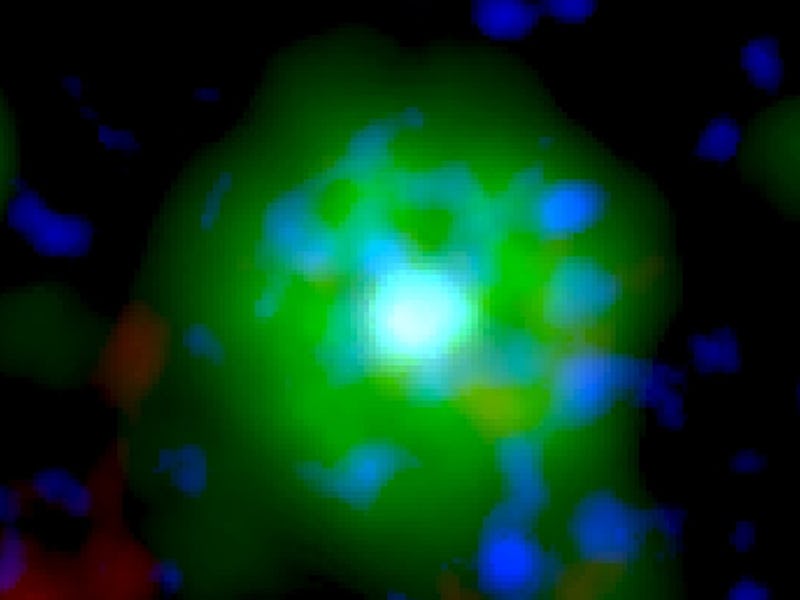New images reveal a neon-green zombie star under new light
Two dead stars came together to form this strange stellar being.

In May 2019, astronomers spotted what appears to be a bright, green blob out in the cosmos. The result of two dead stars colliding into one another, the exact nature of this stellar being has confused and intrigued scientists — until now.
Astronomers were recently able to image the remnant of the stellar merger in X-ray light, revealing new information about its product — a never-before-seen kind of star.
The data gleaned from the image are detailed in a new study published in the journal Astronomy and Astrophysics.
What’s new — The image reveals a central star surrounded by a bright, neon green nebula that encompasses the remains of a rare stellar merger between two white dwarf stars. The image, which calls to mind the 1997 movie Flubber, is a first-of-its-kind achievement for scientists.
This image shows a new type of star that has never been seen before in X-ray light.
This stellar being has never been observed with X-ray light, and it provides scientists with new insight into how dead stars can still evolve, despite their morbid nature.
Here’s the background — White dwarf stars are the haunting remains of large stars that dwindle down to about the same size as the Earth. Near the end of their life, stars around the same mass as our Sun will run out of their fuel and expel most of their outer material, creating a planetary nebula.
In this instance, a pair of white dwarfs crossed paths. The two stars got too close to one another, pulled by the force of each other’s gravity, and collided. After they merged together, they had accumulated enough mass to begin producing heavy elements.
This was a rare occurrence. Perhaps only a half dozen of these mergers have ever occured in the Milky Way galaxy. The team of astronomers behind the new image were lucky enough to have stumbled upon such a rare union by chance.
How they did it — The astronomers made the find while observing the Cassiopeia constellation, which is located in the northern sky, using an infrared telescope.
The star they spotted had no traces of hydrogen and helium — no fuel, in other words — suggesting it was dead. And yet, despite not having those chemical elements, the star glowed tens of thousands of times brighter than our Sun, and had powerful winds equal to the force created by two stars colliding together.
Using XMM-Newton, an X-ray space observatory launched by the European Space Agency in 1999, the team of astronomers managed to observe the stellar being in X-ray light.
ESA's XMM-Newton is the most sensitive X-ray telescope ever built.
What they found — After further examination, the researchers concluded the unusual zombie-like star was indeed the product of a rare white-dwarf merger.
They found that the star was mostly made of neon, which is identified as glowing green in the new image, as well as magnesium, silicon and sulfur.
At the center lies the surviving star, surrounded by a nebula that is the result of a supernova explosion. A supernova is the explosive death of a star, and it leaves behind the luminous remains in the form of a cloudy, stellar grave, which can then give help fuel the creation of new cosmic beings.
The new observations suggest the remaining star is highly unstable, and will likely collapse within 10,000 years — a piece of cosmic ephemera.
Abstract: The merger of two white dwarfs (WDs) is a natural outcome of the evolution of many binary stars. Recently, a WD merger product, IRAS 00500+6713, was identified. IRAS 00500+6713 consists of a central star embedded in a circular nebula. The analysis of the optical spectrum of the central star revealed that it is hot, hydrogen, and helium free, and it drives an extremely fast wind with a record breaking speed. The nebula is visible in infrared and in the [O III] λ5007 Å line images. No nebula spectroscopy was obtained prior to our observations. Here we report the first deep X-ray imaging spectroscopic observations of IRAS 00500+6713. Both the central star and the nebula are detected in X-rays, heralding the WD merger products as a new distinct type of strong X-ray sources. Low-resolution X-ray spectra reveal large neon, magnesium, silicon, and sulfur enrichment of the central star and the nebula. We conclude that IRAS 00500+6713 resulted from a merger of an ONe and a CO WD, which supports earlier suggestion for a super-Chandrasekhar mass of this object. X-ray analysis indicates that the merger was associated with an episode of carbon burning and possibly accompanied by an SN Iax. In X-rays, we observe the point source associated with the merger product while the surrounding diffuse nebula is a supernova remnant. IRAS 00500+6713 will likely terminate its evolution with another peculiar Type I supernova, where the final core collapse to a neutron star might be induced by electron captures.